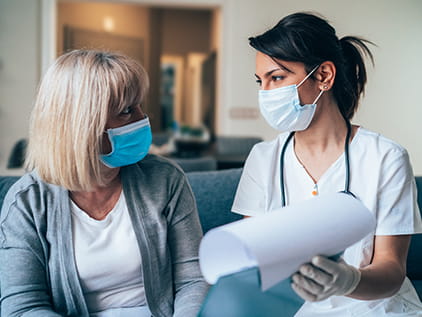February 02, 2022
For some people, wearing a mask – or not – has become a political statement. But if we consider the science, we know that wearing a mask is an easy way you can protect the people around you. You can have COVID-19 without realizing it. And if you spread the virus to someone else, that person may take it home and spread it to someone who would not do well fighting it off. Consider people who are older than 65 as well as people – young and old – who have chronic conditions like cancer, diabetes and heart disease. For them, this virus can mean critical illness or death. Additionally, vaccinated people have lower rates of severe disease and death due to COVID-19 than unvaccinated people – even after adjusting for age, sex, race and ethnicity.
We do many things to protect others from unnecessary harm. We don’t drink and drive. We don’t run stop lights. We don’t shout “fire” in a crowded theater. The same principle applies here. Regardless of vaccination status, wearing a mask in public protects everyone else from the germs that are released every time you breathe, talk, laugh, cough or sneeze. It’s as simple as that.
To protect yourself and the people you love, play it safe by wearing a mask. Here, experts at The University of Kansas Health System have answered a few frequently asked questions about masks.
How to fit your mask
Dana Hawkinson, MD: Improved fit will help reduce the risk of catching coronavirus and help reduce the spread. Currently on the CDC website, they do have that it is important to make sure that you improve the fit of your mask as much as possible. And you can do that by tying the mask or improving the fit of the surgical mask.
So first I want to make sure that I have my hand sanitized with alcohol gel. And the easiest way to do it is to just pick it up before you place it on your face. At that point in time, you just fold it in half. So it's kind of folded like a hot dog bun. Next, you work towards tying the loops. And the easiest way to do this is to do it by two finger breadths, tying the loop around, and you really want to try to get it as close to the mask as possible. But as you can see, we've just tied a simple little knot. Now to the other side. The next step is to kind of get it to form to your face initially. And that is by using the nose and the metal band, and then also pulling it down around your chin.
So obviously you can see here, there are still some gaps. The last part is trying to fold in those open gaps, fold it in around your face so that you can reduce the amount of open space around the mask and the face as much as possible. But once you do that, you should have as little amount of gap as possible. Again, this is all to improve the fit, to improve any open air exchange. If you are expressing the disease or the droplets out into the community, or if you are inhaling as well, this will help.

Learn more
For more information on masks and other ways to protect yourself from COVID-19, visit our update page. Check back often for the latest news about the novel coronavirus.




